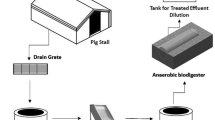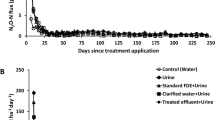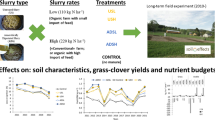Abstract
Pig slurry is characterized by showing high concentration of total nitrogen (0.5–4.0 g l−1), organic matter (20–110 g l−1 CODT), fecal coliforms (103–108 CFU ml−1), and liquid phase content (around 90 %). The high total nitrogen and liquid phase content, makes its use as biofertilizer very interesting. However, in order to avoid greenhouse gas emissions, transformation of organic matter into methane by anaerobic technology comes to be essential. On the other hand, groundwater microbiological contamination by soil transport of pathogens from excreta makes slurry treatment very important. The aim of this study was to evaluate anaerobic technology influence on biofertirrigation onto silty soil using raw and anaerobically treated pig slurry, considering lactose (+) enteric bacteria as main indicators of fecal contamination. Total nitrogen load rates of 350 and 700 kg N ha−1 year−1 were used. The experimental design consisted in soil immobilized in columns. The system fed with raw pig slurry of 700 kg N ha−1 year−1 showed 99 % of bacterial retention, while the system fed with anaerobic effluent of 350 kg N ha−1 year−1 presented a retention of 86.2 %. A positive relation between bacterial retention and organic matter content in slurry was observed. On the other hand, almost the whole amount of the total nitrogen from the leachates corresponded to soil nitrates, and 99.46 %, 99.51 %, 99.35 %, and 99.29 % of ammonium fed was retained in the systems of raw pig slurry of 700 kg N ha−1 year−1, anaerobic effluent of 700 kg N ha−1 year−1, raw pig slurry of 350 kg N ha−1 year−1, and anaerobic effluent of 350 kg N ha−1 year−1, respectively.





Similar content being viewed by others
References
APHA–AWWA–WPCF. (1998). Standard methods for examination of water and wastewater (19th ed.). Washington, DC: American Public Health Association.
Atlas, R., & Bartha, R. (2002). In I. Capella & S. Ayerra (Eds.), Ecología microbiana y ecología ambiental. Madrid: Pearson Education.
Belmonte, S. M., Hsieh, C., Figueroa, C., Campos, J. L., & Vidal, G. S. (2011). Influence of solids contained into piggery wastewater on the methanogenic toxicity. Electronic Journal of Biotechnology, 14(3), 11.
Bouwer, H. (1974). Renovating municipal wastewater by high-rate infiltration for ground-water recharge. Journal of American Water Works Association, 66(3), 159–162.
Chartier, C. (2011). Gram negative lactose positive enteric bacteria retention in silty loam soil columns, after raw pig slurry and anaerobically treated slurry application. University of Concepción, 83 pp.
Chernicharo, C. A. L. (2006). Post-treatment options for the anaerobic treatment of domestic wastewater. Reviews in Environmental Science and Bio/Technology, 5(1), 73–92.
Crist, J. T., Zevy, Y., MacCarthy, J. F., Throop, J. A., & Steenhuis, T. S. (2005). Transport and retention mechanisms of colloids in partially saturated porous media. Vadose Zone Journal, 4(1), 184–195.
Fischer, E. N., & Whalen, S. C. (2005). Rates and controls on denitrification in an agricultural soil fertilized with liquid lagoonal swine waste. Nutrient Cycling in Agroecosystems, 71(3), 271–287.
Gregory, K. J., & Walling, D. E. (1985). Drainage basin form and process; A geomorphological approach. London, pp. 458
Guber, A. K., Shelton, D. R., & Pachepsky, Y. A. (2005). Transport and retention of manure-borne coliforms in soil. Vadose Zone Journal, 4(3), 828–837.
Guber, A. K., Pachepsky, Y., Shelton, D. R., & Yu, O. (2007). Effect of bovine manure on coliform attachment to soil and soil particles of different sizes. Applied Environmental Microbiology, 73(10), 3363–3370.
Hamza, M., & Anderson, W. (2005). Soil compaction in cropping systems. A review of the nature, causes and possible solutions. Soil Tillage Research, 82(2), 121–145.
Hernández, D., Fernández, J. M., Plaza, C., & Polo, A. (2007). Water-soluble organic matter and biological activity of a degraded soil amended with pig slurry. Science of the Total Environment, 378(1), 101–103.
Hudson, B. D. (1994). Soil organic matter and available water capacity. Journal of Soil and Water Conservation, 49(2), 189–194.
Johnson, W. P., & Logan, B. E. (1996). Enhanced transport of bacteria in porous media by sediment-phase and aqueous-phase natural organic matter. Water Research, 30(4), 923–931.
Lewis, J., & Sjöstrom, J. (2010). Optimizing the experimental design of soil columns in saturated and unsaturated transport experiments. Journal of Contaminant Hydrology, 115(1–4), 1–13.
Madigan, M. T., Martinko, J. M. & Parker, J. (2004). Brock, biology of microorganisms. 10th ed. Pearson Education, pp. 1011
Maier, R., Pepper, I., Gerba, C. (2008). Environmental microbiology. Academic Press, pp. 624
McManus, J. (1988). Grain size determination and interpretation. In M. Tucker (Ed.), Techniques in sedimentology (pp. 63–85). Oxford: Blackwell Science.
Montoya, M., & Martín, M. (2005). Análisis de la varianza (ANOVA) en ensayos de lixiviación de N-purín en columnas experimentales. In: Sampler, J. & Paz, A. (Ed.), VII Jornadas de Investigación en la Zona no Saturada del suelo, ZNS'05. Estudios de la Zona no Saturada del suelo (pp. 15–21). A Coruña
Mosaddeghi, M., Mahboubi, A., Zandsalimi, S., & Unc, A. (2009). Influence of organic waste type and soil structure on the bacterial filtration rates in unsaturated intact soil columns. Journal of Environmental Management, 90(2), 730–739.
Navia, R., Soto, M., Vidal, G., Bornhardt, C., & Diez, M. C. (2002). Alkaline pretreatment of kraft mill sludge to improve its anaerobic digestion. Bulletin of Environmental Contamination and Toxicology, 69(6), 869–876.
Navia, R., Levet, L., Mora, M. L., Vidal, G., & Diez, M. C. (2003). Allophanic soil adsorption system as a bleached kraft mill aerobic effluent post-treatment. Water, Air, and Soil Pollution, 148(1–4), 323–333.
Núñez-Delgado, A., López-Períago, E., & Díaz-Fierros-Viqueira, F. (2002). Pollution attenuation by soils receiving cattle slurry after passage of a slurry-like feed solution. Column experiments. Bioresourse Technology, 84(3), 229–236.
Plaza de los Reyes, C., Villamar, C. A., Neubauer, M. E., Pozo, G., & Vidal, G. (2013). Behavior of Typha angustifolia L in a free water surface constructed wetlands for the treatment of swine wastewater. Journal of Environmental Science and Health, Part A, 48(10), 1–9. doi:10.1080/10934529.2013.776852.
Powelson, D. K., & Mills, A. L. (2001). Transport of Escherichia coli in sand columns with constant and changing water contents. Journal of Environmental Quality, 30(1), 238–245.
Provolo, G. (2005). Manure management practices in Lombardy (Italy). Bioresource Technology, 96(2), 145–152.
Rodríguez, D. C., Belmonte, M., Peñuelas, G., Campos, J. L., & Vidal, G. (2011). Behaviour of molecular weight distribution for the liquid fraction of pig slurry treated by anaerobic digestion. Environmental Technology, 32(3–4), 419–425.
Rufete, B., Perez-Murcia, M. D., Perez-Espinoza, A., Moral, R., Moreno-Caselles, J., & Paredes, C. (2006). Total and faecal coliform bacteria persistence in a pig slurry amended soil. Livestock Science, 102(3), 211–215.
Sánchez, M., & González, J. L. (2005). The fertilizer value of pig slurry: I. Values depending on the type of operation. Bioresource Technology, 96(10), 1117–1123.
Smith, J. E., Surampalli, R. Y., Reimers, R. S., Tyagi, R. D., & Lohani, B. N. (2008). Disinfection processes and stability refinements to biosolids treatment technologies. Journal of Hazard Toxic Radioactive Waste, 12(1), 10–17.
Sobsey, M. D., Khatib, L. A., Hill, V. R., Alocilja, E., & Pillai, V. (2006). Pathogens in animals waste and the impact of waste management practices on their survival, transport and fate. In J. Rice, D. Caldwell, & F. Humenik (Eds.), Animal agriculture and the environment (pp. 609–666). St. Joseph: National Center for Manure and Animal Waste Management.
Stevik, T. K., Aa, K., Ausland, G., & Hanssen, J. (2004). Retention and removal of pathogenic bacteria in wastewater percolating through porous media: a review. Water Research, 38(6), 1355–1367.
Topp, E., Scott, A., Lapen, D. R., Lyautey, E., & Duriez, P. (2009). Livestock waste treatment systems for reducing environmental exposure to hazardous enteric pathogens: some considerations. Bioresource Technology, 100(22), 5395–5398.
Tyagi, V. K., Khan, A. A., Kazmi, A. A., Mehrotra, I., & Chopra, A. K. (2009). Slow sand filtration of UASB reactor effluent: a promising post treatment technique. Desalination, 249(2), 571–576.
Unc, A., & Goss, M. J. (2003). Movement of faecal bacteria through the vadose zone. Water, Air, and Soil Pollution, 149(1–4), 327–337.
Unc, A., & Goss, M. J. (2004). Transport of bacteria from manure and protection of water resources. Applied Soil Ecology, 25(1), 1–18.
Valenzuela, M., Mondaca, M. A., Claret, M., Pérez, C., Lagos, B., & Parra, O. (2009). Assessment of the origin of microbiological contamination of groundwater at a rural watershed in Chile. Agrociencia, 43(4), 437–446.
Venglovsky, J., Sasakova, N., & Placha, I. (2009). Pathogens and antibiotic residues in animal manures and hygienic and ecological risks related to subsequent land application. Bioresource Technology, 100(22), 5386–5391.
Vidal, G., & Diez, M. C. (2003). Influence of feedstock and bleaching technologies on methanogenic toxicity of kraft mill wastewater. Water Science and Technology, 48(6), 149–155.
Villamar, C. A., Cañuta, T., Belmonte, M., & Vidal, G. (2012). Characterization of swine wastewater by Toxicity Identification Evaluation Methodology (TIE). Water, Air, and Soil Pollution, 223(1), 363–369.
Zagal, E., & Sadzawka, A. R. (2007). Protocolo de métodos de análisis para suelos y lodos. Chillán: University of Concepción & Chilean Soil Science Association.
Acknowledgments
This study was partially funded by INNOVA BIO BIO 07-PC S1-198 and FONDAP 15130015 grant. The authors thank to Mrs. Patricia Escares form Microbiology Lab for her assistance and Mr. C. Contreras from Sucesión Yanine for allowing access to their facilities.
Author information
Authors and Affiliations
Corresponding author
Rights and permissions
About this article
Cite this article
Chartier, C., López, D. & Vidal, G. Anaerobic Technology Influence on Pig Slurry Biofertirrigation: Evaluation of Enteric Bacteria. Water Air Soil Pollut 225, 1790 (2014). https://doi.org/10.1007/s11270-013-1790-z
Received:
Accepted:
Published:
DOI: https://doi.org/10.1007/s11270-013-1790-z




